Oak Island with the Masons and the Lagina Brothers
Ever since I was a young boy I have been fascinated with pirates and in particular Captain Kidd and his connection to Nova Scotia’s Oak Island. I can date this fascination exactly, as it started with a box of cereal. In the late 1950’s or early 1960’s Shreddies, (my favourite cereal after Sugar Pops which we were only allowed to have on special occasions) started putting treasure maps in their boxes. To a youngster they were fascinating things of great colour and detail and I believed every word that was on them. From what I can gather on the web they were a Canadian promotion only and the drawings were done by one of the Golden Books’ illustrators. To my recollection there were four maps setting out the exploits of Captain Morgan, now more famous for his rum than his pillaging of Spanish colonial cities, Edward Teach, better known as Blackbeard, Anne Bonny the infamous female pirate and of course Captain Kidd.
The map associated with Captain Kidd was that of Oak Island and I was able to actually find a copy of on the web. Looking at it now I can see why it would hold tremendous interest and become a thing of great wonderment to the point that I carried it with me everywhere until it gradually disintegrated from repeated foldings and unfoldings. You can see the money pit on the left hand side, his ship the Adventure Galley flying the Jolly Roger, the map of Oak Island and Captain Kidd regaled as befittingly as any pirate you will ever see. The only thing missing was the parrot.
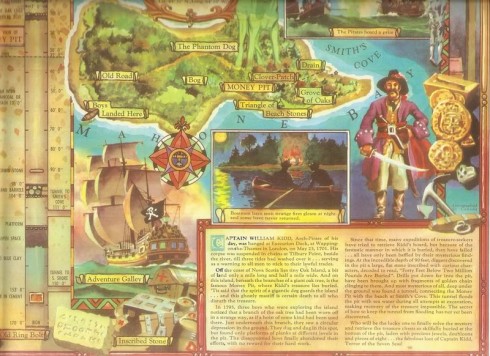
This one little piece of parchment propaganda sent me on a mission of reading everything I could find in the school and town library on pirates, Captain Kidd in particular. Turns out he was actually a pretty shitty pirate; not very vicious, not very successful and not around for a very long time before being hung. However, the one thing that he did do that has become an absolute staple of pirate lore is that he unquestionably buried a treasure. We know this because, in an attempt to defend himself, he led authorities to where it was buried and it was duly recovered. However, the treasure was not on some remote Caribbean cay or on one of the thousands of islands off Nova Scotia, but on Gardiner’s Island nearby the very unromantic Long Island in New York. That fact, coupled with the reference to Captain Kidd in Robert Louis Stevenson’s Treasure Island made sure that Captain Kidd became as famous as his more bloodthirsty and successful contemporaries. If he buried one treasure then surely he must have buried more and so the search was on from the Caribbean to the Arctic Ocean for Captain Kidd’s purloined loot. I personally have climbed a hill not far from Red Bay, Labrador and stood on the banks of a pond that searcher’s are convinced contains one of the captain’s many hidden treasures. Why in God’s name he would haul his treasure over a thousand feet up to throw it in a pond is not a question they want to ponder.
Enough about Captain Kidd, what about Oak Island? Well I will try to say in one paragraph what others have taken many books to describe.
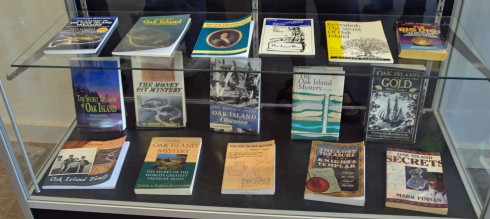
The actual facts surrounding the discovery of a potential treasure site are themselves now a matter of legend and there is no contemporary documentation available, but the story goes that in 1795 three teenagers were visiting the island and found a depression in the ground under a large oak tree and observed a pulley or block and tackle hanging from a limb of the tree. They immediately assumed it must have meant that something important had been buried here and returned to get shovels to dig with. Why anyone would leave behind such obvious signs of a burial remains an enigma. The bottom line is that neither the initial treasure seekers or scores of others have found anything of real value on Oak Island in the 219 years that the hunt has been on. However, what they have found is something that has become one of the world’s greatest mysteries – a series of engineered shafts that go down to depths still unknown, false beaches and incredibly complex drainage systems that long ago dispelled any suggestion that this was a simply buried pirate treasure. Somebody with amazing resources and engineering skills must have spent months at least on the island building this system to protect or hide something, but what.
There are more theories on what may be hidden on Oak Island than on who wrote Shakespeare’s plays and in fact, Shakespeare’s plays is one of the theories. Others involve any number of countries hiding something they thought could be lost to other countries if not secreted, the treasure of the Knights Templar and my personal favourite – the Holy Grail. Since the area was settled not long after Halifax was founded in 1749, it seems to be common sense that it must have occurred before then as such an undertaking could not have gone unnoticed once settlers and fisherman started to frequent the area. However, to my knowledge there are no Indigenous legends surrounding events on Oak Island.
Getting on to Oak Island is technically easy – it is connected to the mainland by a small causeway, but for the past thirty or forty years the treasure mad owners of the island have kept public access to a minimum. There have been periods of years where no one was allowed on, but the treasure seekers. It was during one of these periods in the 1970’s that my desire to visit Oak Island was first partially satisfied when I first sneaked on to the island and made a clandestine visit. At that time there were no permanent residents and the workers returned to the mainland after their shifts. I remember the feeling of trepidation I had as I slinked across the causeway in a stooped over scurry. I remember more the absolute feeling of crushing disappointment on arriving at what I thought was the money pit. Stupidly expecting to see the giant oak tree with a shaft underneath it, I instead saw an industrial mess of broken and rusted machinery amid a huge excavation partially filled with water. There was nothing romantic whatsoever about what had taken place here – it was just a bloody mess. I returned to the mainland disillusioned, but that didn’t stop me from reading every new book about Oak Island that came out or following the sporadic reports of new finds on the island.
About ten years ago the quarrelsome owners of the island decided to sell it and offered to to the Province for about $15,000,000.00. At that time Alison was a deputy minister in the government and I was certain the Province would jump at the chance to acquire it. I knew from visiting the nearby Chester and Mahone Bay tourism bureaus, that Oak Island was by far the most popular place that tourists wanted to visit in the area and that they were always disappointed to find that it was not open to the public. Now the Province would have an opportunity to cash in on the world wide interest in this unique place. To my shock and disgust the Province said ‘No’. Some idiots in the bureaucracy and politicians with no vision decided that the aura that surrounded the island was not worth paying a premium for and declined the offer. Thankfully someone with vision did buy in and that brings me to my recent visit.
Since 1967 most of the island was owned by Dan Blankenship and David Tobias under the corporate name Triton Alliance. In 2006 Tobias sold his interest to Michigan brothers Rick and Marty Lagina and they and the Blankenship interests now operate as Oak Island Tours Inc. They have done three really good things. First they have brought a new supply of money, ideas and enthusiasm to the project and serious efforts to get to the bottom of the mystery are once again underway. Second in collaboration with Friends of Oak Island they have reopened the island to the public on a limited basis with guided tours offered for a very reasonable $10 a person every second weekend or so. Third, the Lagina brothers have made themselves into reality TV series stars with the The Curse of Oak Island on The History Channel, the most popular show ever on that channel and now shown in over seventy countries. The first episode launched in January 2014 and was such a success that it is now into its seventh season. This has led to a greater interest and desire to visit Oak Island across North America and that is a great thing for Nova Scotia tourism.
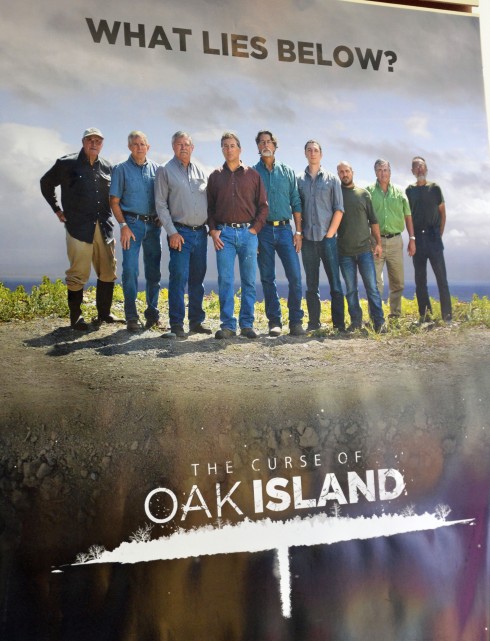
What brought me and Alison to Oak Island was an invitation from our friend Dr. George Burden to join in a tour that was being put on especially for the Free Mason’s. So since when did I become a Mason? Despite the fact that my grandfather, father and one son are/were Masons, my lack of religion kept me from joining, although I have always been fascinated by Masonic symbolism and the powerful role that the Masons have played in U.S. politics. However, George is a Free Mason and was given permission to invite us. The Masons have always had a keen affinity for all things related to Oak Island as it apparently abounds with Masonic symbols. They also have a relationship with the fabled Knights Templar who became one of the wealthiest Christian organizations at the time of the crusades, but eventually fell afoul of the king of France and the leaders were executed and much wealth confiscated by the greedy Philip IV. However, almost from the time of dissolution in 1312 there were rumors of vast hidden stores of Templar treasure somewhere. Today there is a specific branch of Freemasonry which is called the Knights Templar and open only to Christians, as opposed to other branches that require only a belief in a supreme being.
The connection to Oak Island and the Knights Templar comes through the somewhat murky and controversial Sir Henry Sinclair, who while definitely a real person, has had exploits attributed to him that put him closer to Paul Bunyanesque status. There are two things that connect Sinclair very tenuously to Oak Island. The first is the belief by some that he ventured to North America and in particular Nova Scotia over 100 years before Columbus. I have written about this in Exploring Nova Scotia and do not accept that there is more than a modicum of flimsy evidence to support this theory. Using my litigation lawyer’s view of things I don’t see the case as anything but fanciful. However, there are more and more people convinced that Sinclair’s exploits were real. Books like The Holy Blood and The Holy Grail which in turn foster fictional books and movies like The Da Vinci Code are the ammunition for these at times fanatical beliefs. Add in the fact that the Sinclair’s owned and still own Rosslyn chapel which plays a prominent role in both the above books and you have the recipe for not only a grand conspiracy, but one with a Nova Scotia connection. Enough people believe that Sinclair came to Nova Scotia that they erected this monument to him at Guysborough where he supposedly landed.
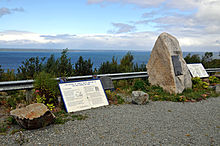
So here we were on Oak Island on a beautiful sunny Sunday afternoon with over two hundred and fifty Freemasons and their families. I have to confess that I was impressed with the Masonic regalia that many wore and the fact that it was a much younger group than I would have expected. I know most service clubs like The Lions, Rotary International and The Kinsmen are struggling, but it appeared that the Freemason’s were quite alive and well with many young members. There was even a Masonic biker club, the Widow’s Sons who had very neat colours.

While waiting for the 2:00 starting time we toured the small museum where there were not a lot of artifacts, but some of them very intriguing indeed. Since 2010 the new owners have found a pair of scissors that the Smithsonian has declared to be of Spanish American origin and at least three hundred years old. There are fragments of low carbon steel brought up from deep within one of the shafts and also dated to more than three hundred years, along with oak and coconut fibres from the same age. So, the reality certainly is that somebody had the technology to not only to make a primitive steel, but the method to get it and the other organic materials down to depths of over 170 feet. Also in the museum is an old shoe found under a rotted wharf that was only discovered a few years ago. Not only is the shoe also hundreds of years old, it is the equivalent of a size fourteen which would have made the wearer a giant in the days when men were much shorter on average than today. There was also this old rail car which was used to transport material from the money pit to a disposal site.
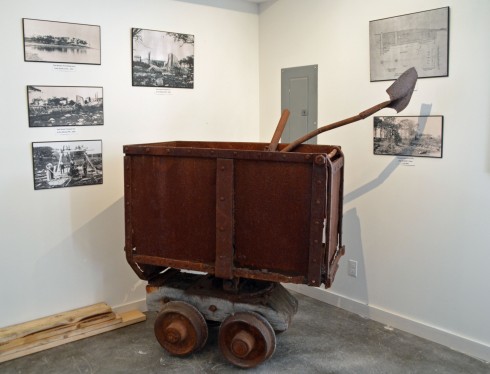
By far the most interesting thing in the museum is a replica of a stone that was apparently found by the original McGinnis group at a depth of over 75 feet in the money pit. It is an incised cypher on a type of stone not found in Nova Scotia which has been translated to read “Forty feet below two million pounds are buried”. Why the persons going to all the effort of hiding the treasure would leave such a clear clue to keep on digging doesn’t make a lot of sense and it is yet another part of the early history of the treasure hunt that is itself shrouded in mystery.
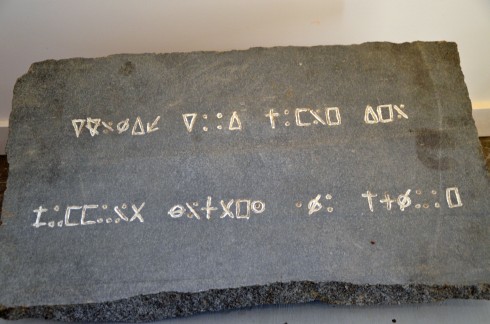
There is also a very good view of the causeway from the deck of the museum.
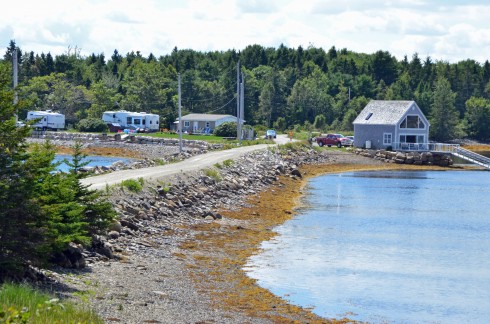
After touring the museum, we assembled out front and were divided into two groups. We were fortunate to get into the group that was led by Charles Barkhouse, a Nova Scotian who grew up in the area and who is the historian of Oak Island. He is one of the regulars on the TV show and he is also a Mason. Over the next two hours I stayed close to him and was able to get a lot of my questions answered by the one person that would know. Because of the size of the group he had to use a megaphone.

The tour of Oak Island is on foot via a gravel road and the total distance traveled on the tour would be less than two miles by my estimate. There were people from eighty to infants in strollers so just about anyone who is ambulatory can do this tour.
The first stop was the foundation of the McGinnis homestead. After initial attempts to find the treasure were unsuccessful the McGinnis family moved to Oak Island to set up permanent residence to make finding the treasure their full time business. While there is nothing unusual about the stone foundation (I have seen many similar in my years of tramping around Nova Scotia), there was a very interesting artifact associated with it. What some believe to be a Portuguese marking stone lies at the back of the foundation, apparently once part of the foundation itself. Here is a photo of an authentic marking stone.
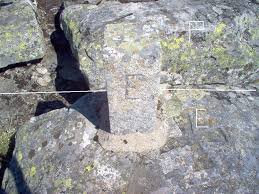
And here is the Oak Island stone.

It is an unusual rock for sure, perfectly rectangular, but whether or not it is a true Portuguese marking stone remains to be verified. The one thing Charles made clear during the tour is that the current searchers do not subscribe to any one of the particular theories about Oak Island and have an absolutely open mind on the subject.
One of the more controversial theories about Oak Island is whether or not certain large boulders are situated in such a way to form various points on a very large Christian cross that covers a large part of the island. Charles pointed out a number of these during the tour, including this one that has obviously been moved to sit atop a cement slab.
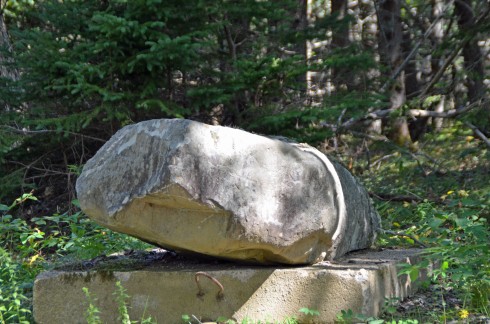
One of the unfortunate things about the ownership of Oak Island is that it remains divided between those who are currently undertaking the search and documenting it for the TV show and Fred Nolan who has had a longtime running feud with the Blankenship’s. He is not cooperative with the new owners and has posted No Trespassing signs on the parts of the island he owns. Obviously being unable to access all parts of the island must be a hindrance to the efforts to get at the truth.
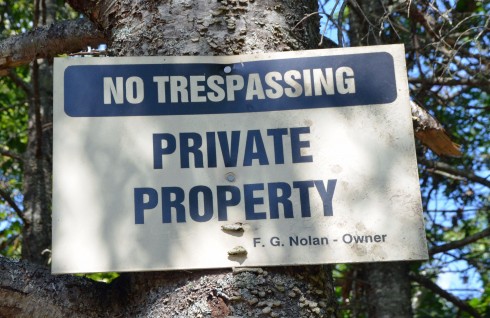
Here I am at the entrance to the Nolan property with the cross stone squarely off limits inside the Nolan boundary.
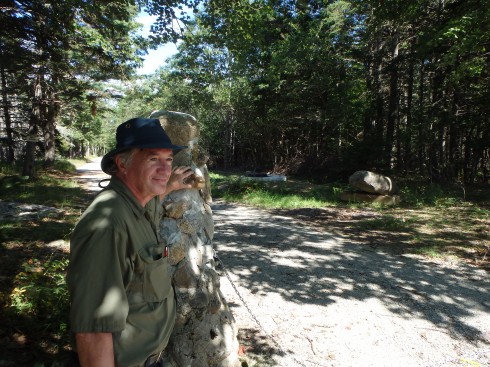
We came to a clearing which Charles explained had once been the lands of one Samuel Ball who was an ex-slave from Virginia who gained his freedom by fighting for the British during the American Revolution. He was one of many freed blacks who along with thousands of other Loyalists were evacuated from New York to Shelburne, Nova Scotia in 1783. He made his way to Oak Island where over the years he managed to acquire almost all of the centre of the island by purchasing lots that had been surveyed out by the Crown. Considering he left New York with only the clothes on his back many have wondered if he found something valuable on the island. Yet another unanswered question.
The production crew was filming an upcoming episode of The Curse of Oak Island in this area as we passed by.

Next up was South Cove from where there is a beautiful view of Mahone Bay with the Tancook islands in the distance.
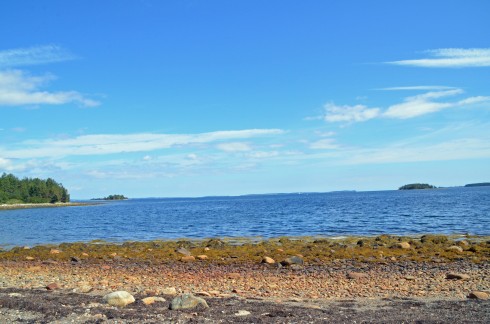
Behind South Cove is what the searchers call ‘The Swamp’ which they believe to be an artificial creation and are currently in the process of draining. They appear to be progressing quite well and while not particularly pretty to look at, these least sandpipers were enjoying it.

Just up from South Cove is the site of another one of Oak Island’s mysterious rock formations. Here searchers many years ago found a man made triangle of stones, the meaning of which is contested. The original formation has long since been destroyed, but the owners have recreated it from preserved drawings. Frankly it’s easier to get an idea of the formation from this sign than seeing it on the ground.
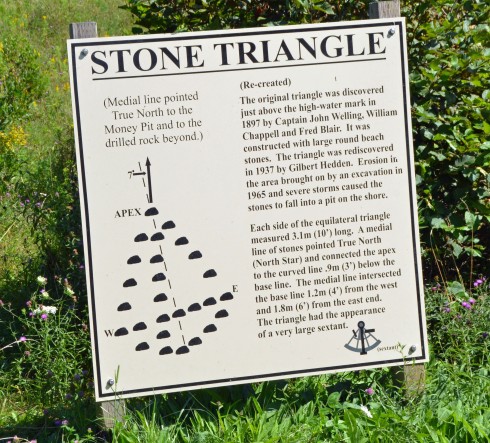
Some claim that it is meant to represent a sextant and it is a fact that it does point in the direction of the Money Pit. To me it looks more like a sailboat. Beside the triangle is an innocent enough looking little pond which Charles explained was once up to ninety feet deep.
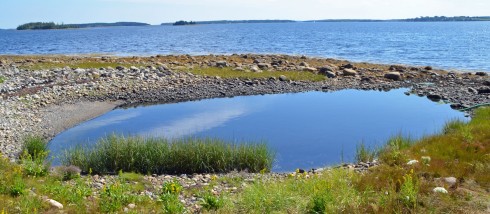
Now we were getting to the serious stuff – the Money Pit. As I wrote at the beginning of this post I had been here many years ago and remembered the disappointment of finding the Money Pit to be unrecognizable as anything close to a treasure site. Not much has changed. The debris has been removed and the pit filled in – there is no pit in the Money Pit. You can clearly see that the entire area has had the top ten feet or so of overburden removed, but it looks more like a gravel pit than a money pit.
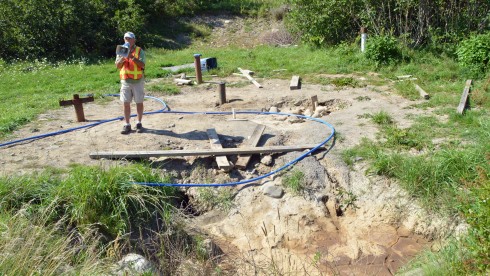
However, Charles did clear up one mistaken impression I had despite having read many books on Oak Island, namely that the Money Pit was not the place where most of the treasure seeking had been undertaken for many years. I had wrongly equated the Money Pit as the place where in 1965 four people were killed when they were overcome by noxious fumes. That site is much closer to Smith’ s Cove. I also wrongly assumed it was the Money Pit down which the CBC stuck a camera in 1971 and appeared to find possible chests and a human hand. This took place at Borehole 10 which really is something worth seeing.
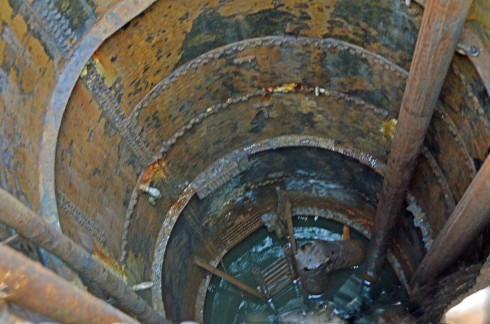
This is an amazing construction that is made up primarily of a series of oil tank rail cars that have had the ends cut off and then welded together and driven vertically into the ground. This hole goes down 140 feet and then there is another fifty feet or so of reinforced concrete until it finally ends where a large underground cavern opens up. However, the cavern is below the water line, so it is filled with water and apparently has a strong current at times. I cannot imagine putting on a wet suit with an oxygen line and climbing down the ladder into the pitch black water over two hundred feet from the surface and trying to find out the dimension of the opening, but that is exactly what Dan Blankenship and his son did on many occasions. Once it almost cost Dan his life as part of the borehole wall was collapsed by some huge unknown pressure.
Just two weeks ago the searchers constructed a wooden platform from which you can peer down into the borehole and trust me, if you suffer from vertigo, this is not the place to be. There is no other spot on the island that brings home so clearly the absolute intrepidation that treasure hunters must bring to their quest.
The tour ends at Smith’s Cove which has long been known to have had an artificially constructed beach which has since been replaced by more modern versions, although looking at it today it looks just like thousands of other little coves on Nova Scotia’s Atlantic coastline.
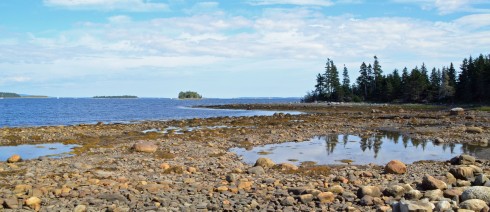
The last thing Charles pointed was a mysterious letter G inscribed in a rock at the edge of Smith’s Cove.
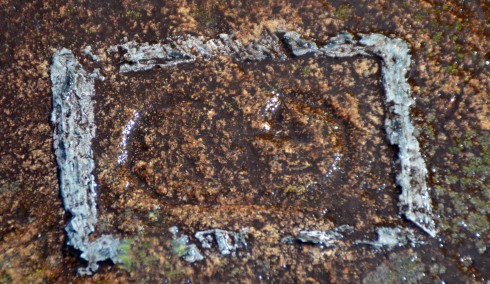
After that we returned to the parking lot where Marty and Rick Lagina along with the TV show’s producer were waiting for us. George and I had a good talk and we told them about the mysterious pentagonal rock foundations and mystery walls at a secret location just outside Halifax as well as our recent trip to Isle Haute where we had observed much evidence of treasure seeking. We learned that the cast, including Charles, had recently returned from Rosslyn chapel and that it will feature in an upcoming episode. Stay tuned!
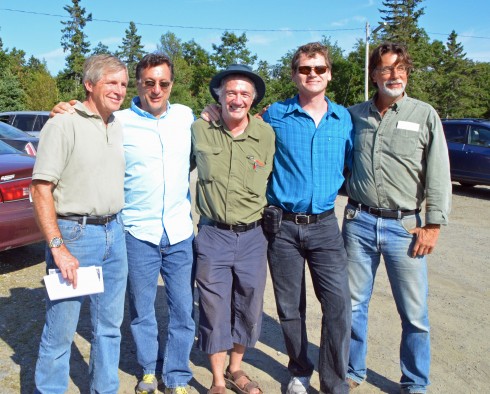
If you are looking for your own adventures in the Halifax area, I recommend a trip, either by foot or canoe to the Blue Mountain-Birch Cove Lakes Wilderness Area. Here’s why.

